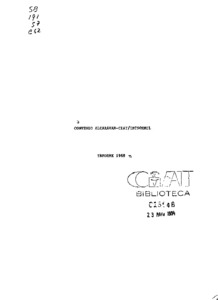Mission
To reduce hunger and poverty, and improve human nutrition in the tropics through research aimed at increasing the eco-efficiency of agriculture.
People
CIAT’s staff includes about 200 scientists. Supported by a wide array of donors, the Center collaborates with hundreds of partners to conduct high-quality research and translate the results into development impact. A Board of Trustees provides oversight of CIAT’s research and financial management.
Values
- Shared organizational ethic
- We respect each other, our partners, and the people who benefit from our work. We act with honesty, integrity, transparency, and environmental responsibility in all of our joint endeavors.
- Learning through partnerships
- We work efficiently and pragmatically together and with partners. Considering our diversity to be a key asset, we adapt readily to change and strive to improve our performance through continuous learning.
- Innovation for impact
- We develop innovative solutions to important challenges in tropical agriculture, resulting in major benefits for the people who support, participate in, and profit from our work.
Members:
Resources
Displaying 806 - 810 of 958Micro-regiones homogeneas para el cultivo de la yuca en parte de Manabi, Ecuador
Convenio ALCARAVAN-CIAT/INTSORMIL
World and Asian markets for cassava products
This analysis of global and Asian markets looks at protectionism and substitution (decline in starch trade, rise in trade of cassava feedstuffs) and the Asian regional market for cassava feedstuffs. The degree of substitution between cassava and grains has increased measurably during the postwar period. Cassava's future in world markets depends on its ability to compete with grains; so far this has depended on grain pricing policies and tariff structures of importing countries, making cassava trade more vulnerable than the international grain trade.
Thailand: rapid growth driven by export markets
In Thailand cassava is produced mainly for export. The Thai cassava industry was based on starch export until the 60s when West Germany began to use CSW for animal feed. As this was a by-product of starch manufacturing, shortages resulted, leading to the market for CM. Chips became the dominant export in 1964 and so did native pellets in 1969, and hard pellets in 1983. Thailand went from a minor producer of cassava in the 50s to presently the 2nd largest in the world. Data are provided on production trends, yields (av.
Malaysia: Cassava vs. tree crops in the competition for land
The agricultural economy of Malaysia has traditionally been export-oriented. Cassava was the 1st of the export crops, established in the 1850s. Malaysia is a land-surplus, labor-scarce economy; thus cassava was planted in a shifting cultivation system giving it the image of a soil-depleting crop. Data are also provided on yields, production systems, production costs and labor utilization, and pricing and market efficiency. The national plan through 2000 emphasizes tree crops, which could affect cassava production.



